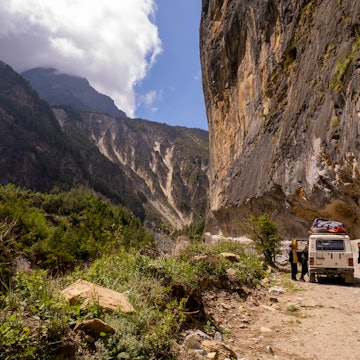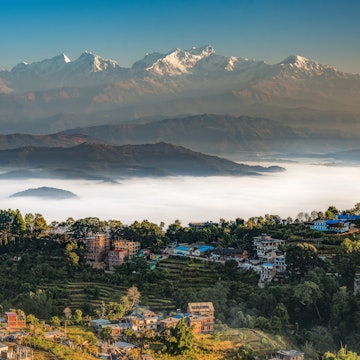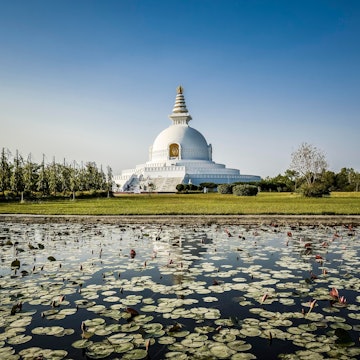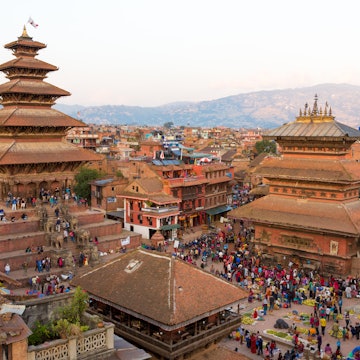

Boudhanath Stupa in Kathmandu, Nepal. zakir1346/Shutterstock
Nepal is small in size but big on variety. Best-known for its mountains, this Himalayan nation also contains historic towns, wildlife-filled national parks, Hindu and Buddhist pilgrimage sites, tea fields and much more.
When planning your trip to Nepal, your main activities should determine your destinations. To trek, head to the mountains, naturally. But which mountains? Each region offers different experiences, and some are easier to reach from the main cities than others.
If your time in Nepal is limited, it's possible to take in the highlights on a 10-day itinerary that includes a couple of days each in Kathmandu and Pokhara with a short trek in the Annapurna Himalaya, and maybe even a jungle safari in Chitwan. Here’s our pick of the top places to visit in Nepal.

1. Kathmandu Valley
Best for historic palaces and temples
Almost all trips to Nepal start in the Kathmandu Valley, and the capital region deserves plenty of time. Historically composed of several separate kingdoms – the most prominent being Kathmandu, Patan/Lalitpur, and Bhaktapur – nowadays, the roughly 25km-wide Kathmandu Valley is one big urban sprawl, with ever-diminishing farmland around the edges. The human history of the valley dates back millennia, and visitors can still see ancient temples and medieval palaces, and encounter traditional indigenous Newari – the people of the Kathmandu Valley – culture, among the haphazard modern concrete constructions.
Of greatest interest to travelers are central Kathmandu, Patan and Bhaktapur. These three ancient towns together comprise a UNESCO World Heritage Site, with seven different monument zones: the Durbar (royal) Squares of Kathmandu, Patan, and Bhaktapur, and the Hindu and Buddhist sites of Pashupatinath Temple, Boudhanath Stupa, Swayambhunath Stupa, and Changu Narayan. Note that although the first six are popular tourist destinations, far fewer people visit Changu Narayan, on the northeastern edge of the Kathmandu Valley, so head there to avoid the hustle in peak season.
Planning tip: Despite common misconceptions, Kathmandu isn’t all that high: at 1400m you’re extremely unlikely to feel any effects of altitude. The weather leans hot more often than not, especially between March and October.

2. Solukhumbu District
For the mighty mother mountain Sagarmatha, aka Mt Everest
When the weather is really, really clear, and if you know exactly where to look, you may be able to get a glimpse of a sliver of Mt Everest (Sagarmatha in Nepali, Chomolongma in Sherpa) from Kathmandu. Otherwise, you’ll need to head to the Solukhumbu District, northeast of the capital, to see the world’s highest mountain.
There’s no road to Everest (on the Nepal side of the border) so most people embarking on the Everest Base Camp trek in the Solukhumbu District fly from Kathmandu to Lukla, a village a few days’ walk from the mountain. Solukhumbu contains the Sagarmatha National Park, and is mostly home to Sherpa people, who have a distinct Tibetan-derived culture.
Planning tip: If you don’t have time to trek into the Solukhumbu District, take a scenic Everest flight from Kathmandu for views of the mountain.

3. Mustang
Best for a taste of Tibet
On the northern side of the Annapurna Range, on the edge of the Tibetan Plateau, is the Mustang Region, a barren, windswept landscape that’s home to ethnically Tibetan people. Catch a short flight from Pokhara to Jomsom through the deepest gorge in the world, the Kali Gandaki Gorge, or take a bone-rattling 160km ride in a 4WD. Or, trek there on the Annapurna Circuit.
Mustang is divided into Lower and Upper, and the distinction matters. Lower Mustang is easily accessible (aside from the logistical challenge of getting there) to all, whereas non-Nepali tourists can only visit Upper Mustang on a guided tour and have to pay a hefty fee of at least US$500 for a special 10-day permit and US$50 per day thereafter. Highlights include the apple-growing village of Marpha, Kagbeni village on the Kali Gandaki River, the Muktinath Temple Hindu pilgrimage site, and Upper Mustang’s walled capital, Lo Manthang.
Planning tip: Mustang is all but inaccessible during the monsoon (June through to early September), when the roads are often washed out and flights frequently canceled, and the winter, when it's extremely cold and snowy, especially in Upper Mustang.

4. Pokhara
Best for a chilled-out lakeside vibe
Pokhara, 200km west of the capital and Nepal’s second city, couldn’t be much more different than Kathmandu. On the shores of Lake Phewa (Phewa Tal) and sitting at the foot of the Annapurna Himalaya, the mountain views from Pokhara are next level.
Many people come to Pokhara on the way to and from a trek in the Annapurnas, as there are vehicle connections and flights to far-flung mountain towns from here. You can also enjoy paddling a rowboat on the lake, affordable sundowners on the Lakeside strip, white water rafting on the Seti River, paragliding from Sarangkot Hill, visiting the Shanti Stupa (World Peace Pagoda), and riding the Annapurna Cable Car up to a lookout across the mountains.
Planning tip: If you suffer from respiratory conditions, or are traveling with kids, you may want to prioritize Pokhara over Kathmandu as its air quality is better, and there’s less traffic.

5. Annapurna Himalaya
Best for numerous trekking trails
You don’t need to venture far beyond Pokhara to reach the Annapurna Himalaya – the trailheads for many treks into this range begin around an hour’s drive from the city. From the distinctive pointed peak of Mt Fishtail (Macchapucchre) to the snowy hulk of Mt Dhaulagiri, the Annapurnas are a seriously impressive mountain range.
Active travelers have many trekking options. Australian Camp/Dhampus and Poon Hill are among the best places in Nepal to visit with family as the treks are easy but the views no less spectacular. If you have more time and stamina, the Annapurna Circuit, Annapurna Sanctuary, Mardi Himal and Lake Tilicho treks are some other options.

6. Lumbini
Best for Buddhist temples and pilgrimage spots
Travelers with an interest in Buddhism won’t want to miss Lumbini, in far western Nepal, as it’s where the historical Buddha, Prince Siddhartha Gautam, was born. Lumbini is a UNESCO World Heritage Site and, as well as the modest attractions directly related to Buddha, such as the Maya Devi Temple where it’s believed he was born, the town contains temples and monasteries built by many Buddhist nations and organizations from around the world.
Planning tip: There’s a small international airport in Lumbini, or it's a long drive from Kathmandu or Pokhara.

7. Chitwan National Park
Best place for wildlife safaris
Nepal isn’t all about the mountains. The jungle-filled plains of the Terai, the southern border area beside India, are home to an array of birds and animals, including the vulnerable one-horned rhinoceros (whose population has swelled in Chitwan over the last decade), Royal Bengal tigers, gharial and mugger crocodiles, and various kinds of deer and birds.
The Chitwan National Park is the most popular of the reserves and parks on the Terai as it’s easily accessible from both Kathmandu and Pokhara. From Sauraha town you can go on safari in the park, visit wildlife rehabilitation centers, and learn about the indigenous Tharu people of Chitwan.
Planning tip: Visit Chitwan in late January or early February, when locals clear the long elephant grass and the wildlife hiding within becomes more visible.

8. Ilam
Best for tea fields and Mt Kanchenjunga views
Often overlooked by travelers because it’s a bit out-of-the-way in eastern Nepal, Ilam is the center of Nepal’s tea-production industry. Despite bordering tea capital Darjeeling in India, Ilam is less of a household name in the tea world, but it shouldn’t be. Travelers can tour the tea fields and admire the views of Mt Kanchenjunga, the third-highest mountain in the world, which sits on the Nepal–India border north of Ilam. Trekking routes in this part of Nepal are similarly lesser-known, but there are plenty of options, including the rugged and challenging Kanchenjunga Circuit Trek.















